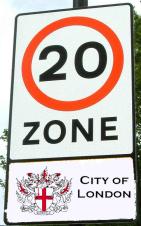
The City of London, the square mile in the heart of Greater London that is home to the city's finance sector, is resetting the speed limit to 20 miles per hour on all streets.
In New York, this would be the equivalent of, say, lowering the speed limit in Manhattan south of the Brooklyn Bridge -- not exactly earth-shattering, but noteworthy for a number of reasons.
Cyclists accounted for 47 percent of all road fatalities in the City of London in 2011. Other 20 mph zones in London have seen injuries and fatalities drop by nearly half. A person struck by a vehicle traveling at 20 mph has a 95 percent chance of surviving the collision.
All other surrounding boroughs (the equivalent of City Council districts) have already adopted a 20 mph limit -- eight of Greater London's 32 boroughs have lowered speeds or are considering doing so, according to the 20's Plenty for Us campaign, suggesting a domino effect. Finally, police support the change, and have called for additional speed cameras and other resources as needed.
"The City of London joins Paris and Tokyo in recognizing that 20 mph limits are better for business and health," said Jeremy Leach, 20’s Plenty for Us London coordinator, in a statement.
There is high demand for 20 mph "slow zones" in NYC neighborhoods where locals live in fear of reckless drivers. Speeding was the leading cause of traffic deaths last year, and speed enforcement is virtually non-existent.
Bill de Blasio has called for more slow zones, and says he wants to dramatically reduce traffic deaths and injuries. Neither Bill Thompson nor Joe Lhota has a detailed traffic safety platform. No candidate has suggested lowering the speed limit to 20 mph on a broad scale, though City Council transportation chair James Vacca has endorsed the idea.





